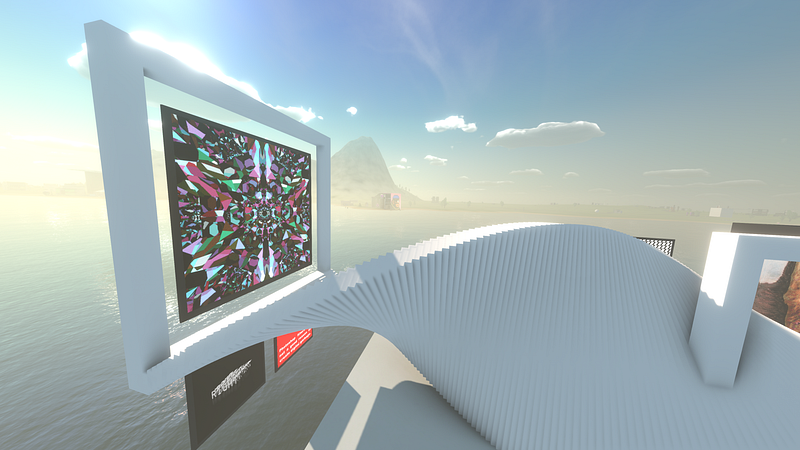Gargantuan artworks and neon shapes flicker far away like distant bug-zappers, attracting meta-wanderers who teleport in atop moonlit fields

Imagine standing at the inception of a new architectural era. Imagine spatial experiences built without the constraints of materiality, gravity, or weather. Architecture freed from itself, from all its former fetter.
This is the promise inherent in the Metaverse’s proliferation: A complete reconceptualization of what architecture is, what it can be, and how we can experience it. As Virtual Worlds continue expanding, we will begin to confront our preconceptions concerning the construction of buildings, public spaces, neighborhoods, and cities. We will have to; it’s practically written into the programming.
Because if Metaverse architecture need no longer provide physical shelter or consider the physical needs of human beings, then what is it? What kinds of expression, creativity, and design become possible? We might need a new word, a new form, an entirely new conceptual framework for this forthcoming practice. But we can’t know these answers until architects arrive in the Metaverse en masse.
The sooner that happens, the sooner we can collectively explore the true possibilities of the Metaverse. The architects come first, and then the rest of us follow. But that progress has hitherto been hampered by the underlying technology which powers these Virtual Worlds. Each one has its own unique set of design constraints and technical standards: individual 3D file-types for instance. This alone is enough of a hurdle to keep traditional architects from knowing how or where to begin creating within the emerging Metaverse.

And it’s the reason why M○C△ has conceived, created, and now presents to the public M○C△ ROOMs: interoperable 3D structures upon which architecture can rise and thrive across all Virtual Worlds. When someone collects and personalizes a ROOM NFT, they are not collecting a single building within a single Virtual World. Instead, ROOMs are architectural blueprints, virtual spaces that can exist in 3, 4, 5, 12, or even 100 different permutations, each customizable to the Virtual World of choice.

Thus, ROOMs encourage architects to not only onboard into the Metaverse, but to collaborate with others outside the limitations of any single, specific Virtual World. ROOMs provide a perpetually-mutable 3D canvas wherein multiple creatives can interact endlessly and concurrently. An architect can (and should! And will!) work alongside interior designers, artists, musicians, and creative directors to build singularly-expressive, wholly-unique structures, to begin probing the Metaverse’s grandest possibilities.
What are its grandest possibilities, exactly? That depends upon the aesthetics and constraints of each Virtual World, their individual missions, what kinds of minds they attract. In Somnium Space, for example, there’s an ingrained emphasis on recreating an Earth-like world, albeit one infused with Dali-like surrealism. Monumental buildings shoot up from grassy hills, from between mountains and atop waterfronts. Sunlight carries slowly across the landscape, shifting into and between the architecture it passes over. At night buildings glow. Gargantuan artworks and neon shapes flicker far away like distant bug-zappers, attracting meta-wanderers who teleport in atop moonlit fields. In contrast, Cryptovoxels or Sandbox use cubes as standard building blocks for every ethereal construction. Decentraland is a sprawling and colorful, low-poly wonderland, while MONA Gallery, Shoyu Metaverse, Arium Spaces, and Spatial offer more tightly-detailed worlds which focus on high-quality renders and explore niche ideas.
Each world will grow along the spines of those who populate it. ROOM holders will have a place in each and every world, so their ROOMs can be as expansive in interest and personality as they are.

Attracting architects to the Metaverse is more than a matter of aesthetic possibilities, however. There are legitimate structural issues in the IRL world of architecture that ROOMs address. In the physical world, architects rarely “own” their work in any traditional sense. If a building changes hands or owners after completion, most architects are financially excluded from that transaction. And yet, the architect, who will never receive monetary compensation for that building beyond an initial commission, will forever maintain primary legal responsibility should there be structural deficiencies, leaks, faults, etc. And that kind of liability just smells wrong. ROOMs are naturally and deliberately designed to challenge that imbalance of equity, by guaranteeing their architects and designers royalties in perpetuity for every sale, exchange, or rental. Architects are artists. And their work deserves to be treated within the Metaverse as all other artwork is treated: with the artist centrally prospering from their creativity, ingenuity, and brilliance.
Today we experience a Metaverse in the pangs of its adolescence; it remains in a kind of Jekyll-and-Hyde personality crisis. Buildings with windows and doors and ceilings have proliferated, but a growing number of virtual buildings are exploring architectural abstraction, constructions closer to sculpture than traditional lived-in structures. ROOMs hope to further this dualistic artistic conversation by offering their first-generation holders a choice between two integral concepts: “Order” or “Chaos.”
Order is nostalgia. Clean lines and corridors and beautiful imitations of real-world spaces. Chaos is a playground, a design concept without inherent limit, challenging notions of space, contortion, and form. Their dualistic push and pull will help mature a new kind of architectural language, one borne of the Metaverse. We will let architects lead the formation of that language. And we hope to use ROOM as a Rosetta Stone.
Interested? Bid on FLOOR here: https://app.museumofcryptoart.com/floor-auction